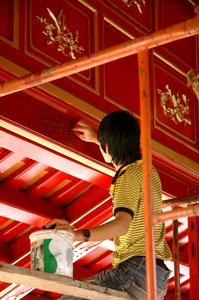Advertisement
Published: January 14th 2010

 Photo 8
Photo 8
Restoration work underway at Hue's Imperial City680km and a 14 hour bus ride later, and I was in Huế, a former capital under the Nguyen emperors and now a centre for culture, education and religion. Like all the best-trodden traveller destinations, Huế has a 'tourist district', which for all their sameness and lack of local character provide an amazingly easy way to change money, check e-mails, grab some food and book whatever needs booking. So, after booking my bus down to Hội An for the following day and re-fuelling with a banana pancake, I headed off on foot to explore the town's Citadel.
Surrounded by huge stone walls and a moat, the Citadel, construction of which began in 1804, dominates the town, with a 37-metre tall flagpole commanding the skyline and the long southern frontage, pierced by the Nga and Quang Duc Gates, ruling the riverbank. Inside the Citadel is an enclosure known as the Imperial City. Surrounded by 2.5km, 6-metre high walls, the city was built by Emperor Gia Long to house himself, his mandarins and other important functions. Part of the complex, known as the Forbidden Purple City, was historically only accessible by the Emperor, his concubines and eunachs, but now, thankfully, no such

 Photo 11
Photo 11
Thien Mu Pagodarestrictions are in place. It's a fascinating place to walk around, partly because the buildings are arranged in pretty, open courtyards and gardens, but also because a lot of restoration is taking place, with the eventual aim of recreating the city in its entirety. Damaged and in parts wrecked by natural events and wars, the Citadel is currently bereft of many of its original buildings, with only the Ngo Mon Gate, Thai Hoa Palace and a collection of small temples and cultural buildings still standing. Those that are currently being restored look resplendent, with fresh red and gold paint and newly carved wood. The only detractor for me were the two sad elephants, charged with carrying tourists round and round the central pond.
Although it was New Year's Eve, I was still on medication which seemed to be working, so I didn't want to jinx it with (more) alcohol, and decided to have a quiet night in (this was my fourth New Year in a row outside England, and the first in a very long time I slept right through!). So I snored as the clock ticked over into 2010 - Chúc Mung Nam Moi Vietnam! Thankfully, I managed

 Photo 12
Photo 12
The car of Thich Quang Ducto catch Big Ben's bongs on TV the next morning, which brought a smile. Beside the Citadel, Huế's other main attractions are the Thien Mu Pagoda and an amazing array of royal Nguyen tombs, which are scattered about the countryside around Huế like glitter. In fact, arriving at Huế is like arriving at no other place I've been, as ordinary graves are strewn in all surrounding fields and paddies, as if they're growing naturally. But it was the royal tombs I wanted to see. So, hiring Mr. Thu's and his moped for the morning, that's where I went.
First up was the Thien Mu Pagoda, a beautiful building perched on the river bank. Built in 1601, its something of a Huế icon, and is also known as being the home pagoda of Thich Quang Duc, whose self-immolation in Saigon in 1963 made world headlines. The car (a lovely old Austin) which drove him to this fateful act is on display in the grounds of the pagoda, which also features some tidy gardens and a collection of well-preserved temples. A very pleasant spot to spend an hour.
I jumped back on the bike and we headed out into the

 Photo 20
Photo 20
The grounds of Tu Duc's tomb complexjungle, to visit the tomb of Minh Mang. Located about 10km out of town, the tomb is accessed via rural dirt tracks, not far from the Song Huong (Perfume River). The grounds reminded me of an English Capability Brown garden, with tranquial lakes fringed by tall green trees and with small pergolas and pagodas dotted all about. The tomb complex itself comprises a number of buildings, including (curiously I thought, it being a tomb) places for the Emperor's son to read, fish, enjoy the scenery and stay with his concubines (a tad morbid?). Most of the complex was only built in 1841-43, but it has a timless quality to it, thanks mainly to the elegant halls and large stone men guarding the entrance. After Minh Mang it was the turn of Tu Duc, whose sprawling tomb perhaps features a greater variety of structures and styles, but slightly less beautiful gardens. Both had their fair share of photogenic, half-crumbling relics. Tombed-out, I got back on Mr. Thu's bike and returned to town, in time for a jacket spud with baked beans and cheese (I do eat local food sometimes you know... I just saw this on the menu and couldn't resist!)
before boarding my bus to Hội An.
Advertisement
Tot: 0.054s; Tpl: 0.014s; cc: 10; qc: 19; dbt: 0.0312s; 1; m:domysql w:travelblog (10.17.0.13); sld: 1;
; mem: 1.1mb






















